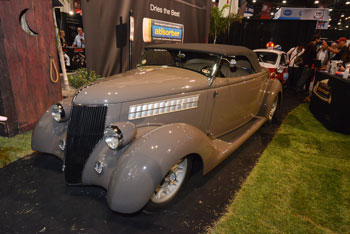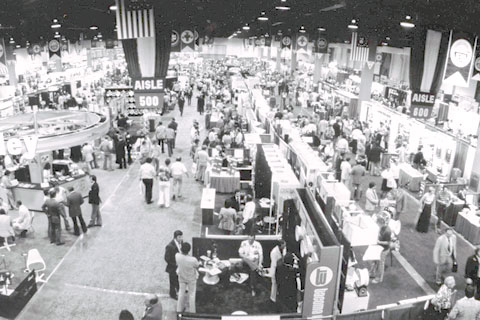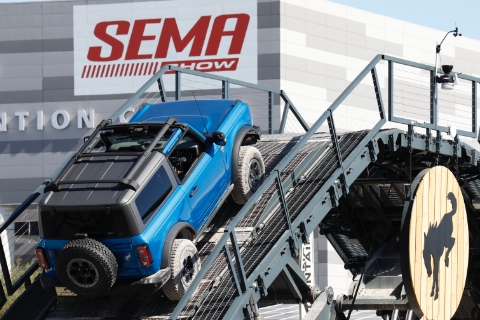BUSINESS
2020 Hot-Rod Market Trends
Old School Meets OBD-II: The Evolving State of Hot Rodding
 Located in Central Hall of the Las Vegas Convention Center, Hot Rod Alley is perennially one of the most heavily trafficked areas of the SEMA Show and home to some of the automotive aftermarket’s oldest and most recognizable performance-parts manufacturers. In 2019, more than 160,000 industry professionals attended the Show. Located in Central Hall of the Las Vegas Convention Center, Hot Rod Alley is perennially one of the most heavily trafficked areas of the SEMA Show and home to some of the automotive aftermarket’s oldest and most recognizable performance-parts manufacturers. In 2019, more than 160,000 industry professionals attended the Show. |
Throughout the years, the automotive aftermarket has adapted many times to changes in consumer taste and advances in product development. Through it all, however, Hot Rod Alley at the SEMA Show has remained a steady industry focal point, providing a forum for some of the aftermarket’s leading lights to showcase their latest, most innovative parts and projects. What began with a handful of fabricators tinkering with pre-war Fords in their home shops has blossomed, decades later, into a global industry boasting thousands of builders who comprise a $1.26-billion market, according to the most recent survey from the Hot Rod Industry Alliance (HRIA).
Editor’s Note: The interviews interspersed in this article were conducted shortly before the Covid-19 outbreak and should be regarded in that context.
The vehicle platforms preferred by builders have likewise expanded due to a recent event that changed the face of hot rodding and which continues to drive its evolution today: In 2018, the Goodguys Rod & Custom Association revised its show eligibility list to include vehicle makes and models up to the ’87 model year in its nationwide show series. In a stroke, ’60s and ’70s musclecars (long a favorite of performance builders) and light-duty pickups became eligible for hot-rod show status. That in turn spurred the development of thousands of new aftermarket products for those platforms, and trucks and musclecars are now among the hottest players in the hot-rod marketplace.
Like other enthusiast-driven vehicle segments, hot rodding faces a number of challenges in the coming years while also presenting opportunities for future growth. For this article, we contacted some two dozen industry insiders representing manufacturers, fabricators, racers, retailers and media. What follows is a compilation of their insights.
Computer-aided design, 3-D printing and CNC machining are increasingly becoming more integrated into the craft of hot-rod building, and there was no better example at last year’s SEMA Show than the Battle of the Builders-winning ’69 Camaro built by Mike and Jim Ring of Ringbrothers. The bodywork is 100% carbon fiber that was CNC machined in high-density foam. |
The State of the Market: Cautious Optimism
Overall, our industry experts agreed that the hot-rod market remains strong—with some caveats. Kyle Tucker, president of Detroit Speed and the 2018 SEMA Show Battle of the Builders winner, noted that consumers seem to have become more guarded lately in their purchasing decisions: “The economy has been strong for so long...but we know there will be a dip, so people seem to be making ‘driver’-quality builds in segments—not necessarily a full-on build all at once.”
Shawn Brereton, editorial director at Power Automedia, pointed to the ongoing U.S.-China trade dispute and the general uncertainty surrounding a presidential election year as potential market drags, as well as the consolidation taking place in the aftermarket. “The collapse of automotive print titles and recent venture capital sales/mergers are leading companies to rethink their spending budgets or take a wait-and-see approach,” he noted.
Goodguys Rod & Custom Association Chief Operating Officer Andrew Ebel sees the market as undergoing “a major evolution right now” as changes in market segmentation and consumer purchasing preferences exert a greater influence over the conventional business model.
“From the continued consolidation of major brands and an ever-changing automotive media landscape to the unrelenting shift and growth from brick-and-mortar retail to e-commerce, it’s becoming more challenging than ever to do business and get the positive results that the industry has been accustomed to in the past,” Ebel said. “In a nutshell, it’s taking more effort and resources than ever to run a successful business in the aftermarket automotive marketplace.”
 As time passes, older ’30s and ’40s Fords become more rare on the hot-rod show circuit, but there are still plenty of fine examples in circulation such as this ’36 roadster sporting hundreds of one-off parts and accessories. Built by Eric Perratt at Pinkee’s Rod Shop, it was named America’s Most Beautiful Roadster for 2019 and was a finalist at the 2019 Battle of the Builders competition. |
Market Drivers: Pickups, Late Models, Restomods and Daily Drivers
As with last year’s survey, nearly all of our industry sources pointed to pickup trucks as among the market’s prime movers. Brereton specifically called out “the C-10 and OBS trucks being built in a performance-oriented/Pro Touring style, as well as the introduction of events designed for them. The C-10 and F-100 have been hot but are getting hotter with the proliferation of a ton of aftermarket support. This year will mark the first year for a Pro-Touring Truck Shootout, and it will be interesting to see how the event turns out.”
Tucker agreed: “Trucks are still strong, and more and more companies continue to expand their product lines to cover the GM and Ford truck market from the ’60s to the ’90s.”
Another trend driving the market has been the increased growth of restomodding, the process of restoring a classic vehicle—often, a later-model platform—to its original or near-original appearance while incorporating myriad modern-day high-performance parts and technologies into the build. According to the HRIA’s most recent industry survey, roughly a third of all builders cite restoration as their primary reason for modifying their classic cars. (By contrast, only 20% of builders now modify primarily for more power or faster speeds, though engine and engine-related parts continue to be the most popular in the segment.)
“We see a consolidation of segments that used to be clear silos in the industry,” Hushmat/ZyCoat Founder and Chief Executive Tim McCarthy observed. “For example, the restoration market seems to be consolidating with the hot-rod segment. The lines between the two are blurred, with the hot-rod segment being the dominant future category, in our opinion.”
Steele Rubber Products President and CEO Joanna Agosta Shere concurred on the growing popularity of late-model restoration, adding that “now we’re seeing a ton of requests for parts for ’80s and ’90s Astro vans. We recently came out with a line of products to serve those vehicles due to customer requests.”
More than one of our sources noted how the build priorities of the next generation of enthusiasts are changing the marketplace.
“Baby Boomers today are handing down their hot rods to sons or daughters, and this new generation is not worried about having a Ridler Award winner,” said Mike Hamrick, events and promotions manager at Wilwood Engineering. “Hot rodders today want their cars to be drivable. The number of show cars has decreased, while the number of daily drivers has seen a spike.”
He noted that “75% of our customers are purchasing smaller brakes to fit stock wheels.”
Alan Johnson, owner of Johnson’s Hot Rods, observed a similar trend, noting that “as more road-tour-type events increase, high-quality drivers are in more demand to perform as well as they look, with all the modern comforts of home.” He added that “increased retro EFI applications offer customers driving adaptability to whatever conditions their journey takes them.”
“The shift from traditional street rods, hot rods and customs to high-performance musclecars, trucks and late-models can’t be overlooked,” Ebel said. “While core traditionalists are still around and are still the cornerstone of our hobby, newer enthusiasts are younger, more time-sensitive, have additional interests outside of hot rodding and are, in many cases, interested in different types of cars than their grandpa, uncle or dad was.”
Accompanying the transition to newer underhood technologies has been the adoption of high-tech fabrication processes by modern-day hot-rod builders, including computer-aided design, CNC machining and 3-D printing. A prime specimen of that trend was the 2019 SEMA Show Battle of the Builders winner: a ’69 Chevy Camaro built by Mike and Jim Ring of Ringbrothers that sported 100% CNC-machined carbon-fiber bodywork.
“The advancements of shop equipment have led to making one-off parts to production parts more cost- and time-
effective,” Johnson said. “The advantages of rapid prototyping of parts allow builders to test fit, adjust and finalize without wasting material and finish costs and without delaying the timeline of the build.”
As McCarthy summed up: “The hot-rod builders offering incredible craftsmanship and integrating great technology in their builds are a driving force in the market.”
Another future market mover that was cited by more than one of our sources was the integration of electric and alternative-fuel propulsion technologies into the marketplace. That trend was on display at the 2019 SEMA Show at SEMA Electrified, a first-time standalone exhibit spotlighting the latest trends in electrification and its potential impact on the aftermarket.
The exhibit featured several one-off performance electric conversions on display, including the drag car owned by racing legend Don Garlits that set an electric-vehicle (EV) land speed record of 189 mph in 2019. With electric motors now capable of producing that much power, it seems only a matter of time before EV technology becomes more frequently seen between the framerails of restomods and
street rods.
“Will electric cars kill hot rods?” Brereton asked. “I don’t think so. The market will certainly change, but it always seems to find a way to adapt or reinvent itself.”
Too new to be considered for “classic” hot-rod status, this 2019 “Lithium” Mustang that was on display at the Ford booth at the 2019 SEMA Show still offers a glimpse into the future of musclecar building—a Webasto electric powertrain conversion that’s said to deliver 1,000 lb.-ft. of torque. A number of our industry sources expect to see increased incorporation of electric propulsion systems in the future hot-rod marketplace. |
Future Challenges and Opportunities
Many of our sources mentioned the rapidly shifting media landscape as a potential market disruptor, as traditional print-based commercial media gives way to streaming video and social media as preferred tools of consumer engagement.
“The collapse of print magazines has been spoken about for years, but it has finally happened—and sooner than I thought,” Brereton said. “Only time will tell if it is a good or bad thing, but I’ve already seen smaller niche titles popping up to fill in the void. Additionally, video has leapt to the forefront, whether it be hosted on a company website, Facebook or live-streamed. But I think companies are still trying to figure out the best ways to utilize it, not to mention make it profitable.”
On a related note, Hamrick called out “the migration over the last couple of years to digital advertising. The way that consumers receive and search for information has changed drastically, as has the speed in which it’s received. Researching a product online and finding good technical content from a reliable source is paramount. All companies—not just ours—must embrace this new media and deliver clear and concise content to a younger generation on their phones as they look for guidance from industry experts.”
But the movement away from traditional media holds its share of opportunities, as Ebel explained, by “forcing savvy marketers to take more active control by rounding out their traditional core marketing efforts (print, direct mail, etc.) with extensive behavioral-based digital and social-media activation. This can allow the more progressive companies to fight through the clutter and effectively target and message to a larger than ever base of prospective consumers at a fraction of the price of traditional media.”
Another challenge mentioned by our sources was that of attracting a new generation of enthusiasts to the hobby. As Tucker noted: “Our industry has competition today with cell phones and gaming computers. Instead of buying a $1,000 project car or truck, some kids want a $1,000 phone and a few apps to entertain them. I believe that we need to understand what holds their interest and energy in order to get the youth involved.”
One industry initiative aimed at attracting and nurturing the next generation of builders is Hot Rodders of Tomorrow, a nationwide series of engine-building competitions featuring teams of high-school auto-shop students competing for the chance to win scholarships to sponsoring colleges and technical schools.
The series began in 2008, with five teams of 35 students competing at a performance expo in Illinois. By 2019, the series had expanded to include 14 regional events, and 41 teams qualified for the series’ Dual National Championships, which were held at the SEMA Show in Las Vegas and, a month later, at the PRI Trade Show in Indianapolis. In all, $3.8 million in scholarship vouchers were awarded to the winning competitors, and more than 50 aftermarket sponsors participated in the program.
Hot Rodders of Tomorrow is a nonprofit organization that holds a series of engine-building competitions throughout the year with the aim of encouraging the next generation of builders—specifically, high-school students—to refine and show off their skills. The SEMA Show hosts one of the series’ final events each November; the PRI Trade Show hosts the other the following month. |
On a related note, the increasingly prohibitive costs of higher education at many four-year colleges and universities could make careers in the automotive aftermarket more attractive alternatives to young enthusiasts. Brereton noted the recent surge in trade school enrollments (up 28% from 2009–2014, according to a study published by the National Center for Education Statistics) as an opportunity to attract a new influx of builders
and fabricators.
“For the first time in decades, there is talk of reintroducing kids to the trades instead of burying themselves in debt to obtain a degree they may never use—even if it is just something to fall back on,” he said. “SEMA has started some initiatives to help in that respect, but it’s going to have to be embraced by those outside of the industry for things to change on a grander scale.”
An additional trend that’s affecting the market is the growing degree of influence that internet culture in general and social media in particular are exerting on consumer shopping preferences, and the need for manufacturers to have a robust online presence to stay relevant in the market.
“Today’s customer is different from what we had 15–20 years ago—or even five years ago,” Tucker said. “New customers coming into our industry many times do not recognize the long-running brands that gearheads growing up in the industry know. If new customers are online, they are there to reach manufacturers and make opinions based on social-media strength. The playing field is different today, and if you have a good online and social-media look, the playing field can be more equal than ever.”
Ebel added that the new generation of aspiring enthusiasts is often “super-excited and ready to cruise, but maybe not so ready to take on a restoration or build. This has led to a demand for more bolt-on products and, in some cases, services that can be tackled by a car guy or gal with some basic mechanical skills and that can be completed in a weekend rather than over months or years.
“The positive thing about this is that it is forcing companies—both old and new—to develop more cutting-edge products and technology that supports the needs of the new-age gearhead. We’re seeing some great new products being engineered and launched every year, and there doesn’t appear to be any slowdown in that area anytime soon.”
Tucker agreed, concluding that “there is growth within that age group if we answer the call correctly.”
Hot-Rod Industry Resources:
Hot Rod Industry Alliance (HRIA): The SEMA HRIA council works to ensure the future prosperity of the hot-rod industry and to advance and promote awareness of the hobby. To learn more about how your business can become involved and benefit from the community, visit www.sema.org/hria.
SEMA Action Network (SAN): The SAN is a nationwide partnership between vehicle clubs, enthusiasts and members of the specialty auto parts industry who want to protect their hobby. Founded in 1997, the SAN was designed to help stamp out legislative threats to the automotive hobby and pass favorable laws. To learn more and join, visit www.semasan.com.



